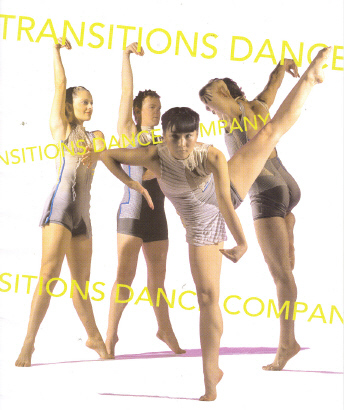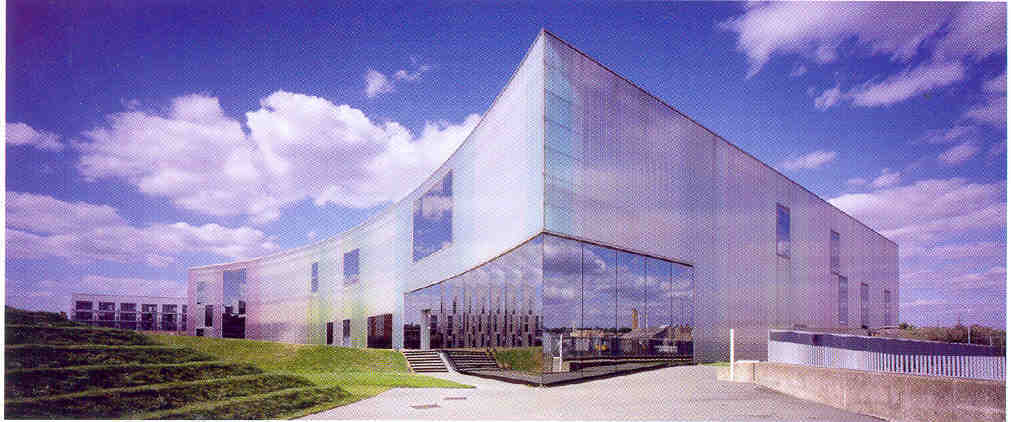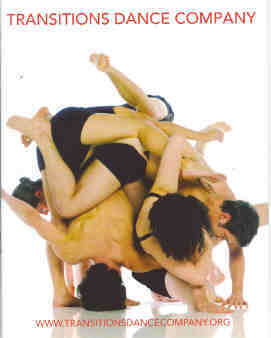|  Transitions Dance Company: Mixed Bills Transitions Dance Company: Mixed Bills
Laban, Deptford 3 May 2006
Laban, Deptford 2 May 2007 (then on tour)
Affordable and accessible, in one of London's most beautiful and breathtaking new venues, Transitions Dance Company is Laban's own, for advanced students of international origin, and they tour mixed bills each season.
The aesthetics are so various that few will enjoy everything, but stimulating evenings, put over with energy and high skill, are assured, backed by splendid state-of-the-art technical equipment in one of the Capital's most audience-friendly theatres.
This year the new works are by choreographers , Athina Vahla (Greece), Thomas Hauert (Switzerland) Rashpal Singh Bansal and Sarah Michelson (UK). Our own reactions illustrated divided perceptions, but it has to be said that everything was greeted by the young audience with the shrieks of glee which have increasingly tended to replace hand-clapping.
I was stunned by the vigour and rough violence of Vahla's take on the Spanish bull-ring. Tall figures sharpening knives made a memorable image to open a series of sinister interactions which "render human desire futile". The music by Vivaldi, Cave & one of Schubert's most moving songs (disseminated at just the right level) contributed to a satisfying whole.
Rashpal Singh Bansal faster, dynamic expression of 'feelings in an alienating situation' were powerfully related to an abstract non-melodic score which showed off the sound equipment; loud, but undistorted. Some of Sarah Michelson's ideas on Swan Lake might have been more at home in a sleazy Soho club? Her programme note is limited to creditting all concened; the sound track has her thanking everyone very, very much... For a radical reworking of the Petipa ballet, give me Matthew Bourne!
Hauert's Fold & Twine divided us; see AW's response below.
I was alienated by the music (anything might have served) which was unrelated to the exploration of 'rules to dance improvisation within a grid'. A Bach harpsichord Allemande was subjected to recorded performances by Alison Balsom (trumpet) and Antal Szalai (violin) mixed by Thomas Hauert - surely without permission? - into "his own original score". That was projected so very loudly that relief required covering my ears, which made it harder to concentrate on the messy rushing around on stage.
Not for the first time has Musical Pointers needed to comment on the propriety of misusing harpsichord music for dance, especially as mediated by the engineer entrusted with Laban's volume control - a vital member of the team!*
Bearing in mind the close link with Trinity College of Music, it surely would have been possible for this music to have been presented acoustically by a couple of Trinity students at side-stage for the home-based performances in Deptford, impracticable though that might be on tour. PGW
Thomas Hauert's Fold & Twine 'a visceral and allusive tour de force' by AW:
Hauert creates extraordinary shapes with the dancers' bodies - negative spaces become positive - living and moving sculptures. At times they squirm like pupae trying to escape their confines, their escape creating palpable relief from tension. The image of the dancers lying on the floor, evoking a giant fringed marine creature, with legs and arms wafted gently by invisible currents and gradually dying down will long reverberate as a metaphor for the fragility of life..Alexa Woolf
Mixed Bill 2 May 2007
New choreography by:
Jenni Kivela (Finland) November
Aszure Barton (Canada) Alto
Pablo Ventura (Spain) Nexus-6
Cristian Duarte (Brazil) IT
This is an annual date always eagerly awaited, the culmination of the work of another group of graduate dancers "taking their first steps into the professional dance arena".
This year's were as astonishing as those before, and their programme had a breathtaking diversity. November was charming and unusual for the inclusion of speech texts, which helped to individuate the dancers. The work displayed huge energy and impressive precision, and was accompanied by interesting music scores from Nat King Cole to Bizet, transmitted at just the right volume. If there were a video or DVD to be had, it is one we would play again and again for ourselves and to guests.
Alto was developed without prior "strategy or conceptual idea". You'd never guess, so clever was it in counterpointing scores by Pergolesi and Vivaldi with interesting movement and interactions between the dancers.
But here Musical Pointers has to enter a caveat, the same as for WHITE SPACE to Scarlatti* last year. It was inordinately loud, making one harbour suspicions that those involved in that important decision may never (as was the case for dance fans sitting next to us) have heard baroque music live? I don't think it really helped to raise the excitement which was generated in spades by the dancing. It also indicated an absence of overall control for the show as a whole?
If Transitions Dance Company feels obliged to dance exclusively to recorded sound, then they should experiment with different levels, and try to find out if audiences react less positively if the music is delivered at more or less concert levels; even though we know that kids like it loud... And what has happened to the potential for live music which should be easily available through the Trinity/Laban association with the prestigious local College of Music in Greenwich?

* - -
WHITE SPACE to sonatas from the Scarlatti's 'Complete Works' (sic) had the dancers accompanied by a recording which was grotesquely over-amplified - perhaps to drown the noise from the kids? An opportunity lost to introduce young audiences to an instrument they might never listen to again, one which can hold its own without having its character totally changed.
|



